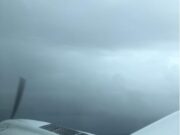Sir Stuart Matthews, who earned a pilot license before he could drive a car and went on to lead Fokker Aircraft U.S.A. and later to head Flight Safety Foundation, died Oct. 13 in Port Saint Lucie, Florida, U.S. He was 88.
Matthews was president and CEO of the Foundation from 1994 until his retirement in 2006. He previously had been a member of the FSF Board of Governors since 1989 and chairman of the Board since 1991.
During his years with the Foundation, he was among the early advocates of a data-driven approach to identifying the major causes of accidents — specifically controlled flight into terrain (CFIT) and approach and landing accidents — and developing guidelines for their prevention. The programs that resulted from those efforts, including the CFIT training aid and the Approach and Landing Accident Reduction (ALAR) Toolkit, have been credited with helping reduce the risk of these deadly accidents.
When he accepted Flight Safety Foundation’s top job, he said he would work to enhance the Foundation’s role as “the conscience of the industry.” He said the Foundation’s purpose was to “vigorously point the way and to show how to prevent accidents. Safety cannot be compromised in an industry that is changing so rapidly.”
The Foundation’s current president and CEO, Dr. Hassan Shahidi, praised Matthews as a determined advocate not only for ALAR and CFIT prevention programs but also for a long string of safety initiatives.
“Stuart was a determined and persuasive advocate for aviation safety,” Shahidi said. “He was a relentless champion of the Foundation’s efforts to reduce the overall accident rate and to address the human factors elements of flight and maintenance operations, aircraft design, and aircraft manufacturing — factors that led to so many accidents. His work was a major contribution to the drive to make aviation the safest form of transportation.”
A native of England, Matthews earned his pilot license when he was 17. Two years later, he worked with friends to build an airplane that he later flew.
For years, he flew in the Royal Air Force Volunteer Reserve and was a commissioned officer. He logged more than 5,000 flights as a glider instructor.
In 1953, he began work with de Havilland Aircraft. In 1964, he worked for British Aircraft Corp. and its Concorde program, and eventually joined British Caledonian Airways as a fleet planner; he later was responsible for corporate planning for the airline.
In 1974, he accepted a job intended to reintroduce Fokker Aircraft in North America. He established Fokker Aircraft U.S.A., which he led for 20 years before he retired as its chairman. Upon retirement, he was knighted by the queen of the Netherlands, who cited his service to aviation.
He was a fellow of the Royal Aeronautical Society and a member of the American Institute of Aeronautics and Astronautics and has a place on the Smithsonian National Air and Space Museum Wall of Honor.
